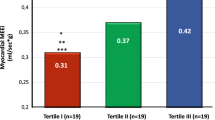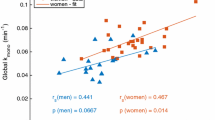Abstract
Background
Because studies in animal models of type-2 diabetes mellitus (DM) show that excessive myocardial fatty acid (FA) metabolism (at the expense of glucose metabolism) cause cardiac dysfunction, we hypothesized that women with DM would have more FA and less glucose myocardial metabolism than normal or even obese (OB) women.
Research Design and Methods
Women who were lean volunteers (NV) (N = 14; age 35 ± 17 years, body mass index 23 ± 1 kg/m2), OB (N = 28;31 ± 6 years, BMI 39 ± 7 kg/m2), and DM (n = 22; 54 ± 11 years, BMI 38 ± 5 kg/m2) were studied. Cardiac positron emission tomography was performed for the determination of myocardial blood flow, oxygen consumption, FA and glucose metabolism. Cardiac work was measured by echocardiography and efficiency by the ratio of work to myocardial oxygen consumption.
Results
Fractional glucose uptake was comparable between NV and OB but lower in DM (P < .05 versus NV). Myocardial FA utilization and oxidation were both higher in DM compared with NV and OB (P < .0001). Myocardial FA utilization and oxidation had positive correlations with HOMA (R = 0.35, P = .005 and R = 0.40, P = .001, respectively) whereas fractional glucose uptake exhibited an inverse correlation (R = −.31, P = .01). Cardiac work and efficiency were similar among the three groups.
Conclusions
In women, the presence of OB and DM compared with OB alone is associated with a greater reliance on myocardial FA metabolism at the expense of glucose metabolism. These perturbations in myocardial metabolism are not associated in a decline left ventricular efficiency or function suggesting that the metabolic perturbations may precede an eventual decline left ventricular function as is seen in animal models of DM.


Similar content being viewed by others
References
Mokdad AH, Ford ES, Bowman BA, Dietz WH, Vinicor F, Bales VS, et al. Prevalence of obesity, diabetes, and obesity-related health risk factors, 2001. JAMA 2003;289:76-9.
Cowie CC, Rust KF, Ford ES, Eberhardt MS, Byrd-Holt DD, Li C, et al. Full accounting of diabetes and pre-diabetes in the U.S. population in 1988-1994 and 2005-2006. Diabetes Care 2009;32:287-94.
Kannel WB, Hjortland M, Castelli WP. Role of diabetes in congestive heart failure: The Framingham study. Am J Cardiol 1974;34:29-34.
Kenchaiah S, Evans JC, Levy D, Wilson PW, Benjamin EJ, Larson MG, et al. Obesity and the risk of heart failure. N Engl J Med 2002;347:305-13.
Curtis JP, Selter JG, Wang Y, Rathore SS, Jovin IS, Jadbabaie F, et al. The obesity paradox: Body mass index and outcomes in patients with heart failure. Arch Intern Med 2005;165:55-61.
Kannel WB, McGee DL. Diabetes and cardiovascular disease. The Framingham study. JAMA 1979;241:2035-8.
Wenger NK, Speroff L, Packard B. Cardiovascular health and disease in women. N Engl J Med 1993;329:247-56.
Boudina S, Abel ED. Diabetic cardiomyopathy revisited. Circulation 2007;115:3213-23.
Unger RH. Lipotoxic diseases. Annu Rev Med 2002;53:319-36.
Young ME, McNulty P, Taegtmeyer H. Adaptation and maladaptation of the heart in diabetes: Part II: Potential mechanisms. Circulation 2002;105:1861-70.
Boudina S, Sena S, Theobald H, Sheng X, Wright JJ, Hu XX, et al. Mitochondrial energetics in the heart in obesity-related diabetes: Direct evidence for increased uncoupled respiration and activation of uncoupling proteins. Diabetes 2007;56:2457-66.
Zhou YT, Grayburn P, Karim A, Shimabukuro M, Higa M, Baetens D, et al. Lipotoxic heart disease in obese rats: Implications for human obesity. Proc Natl Acad Sci USA 2000;97:1784-9.
Peterson LR, Herrero P, Schechtman KB, Racette SB, Waggoner AD, Kisrieva-Ware Z, et al. Effect of obesity and insulin resistance on myocardial substrate metabolism and efficiency in young women. Circulation 2004;109:2191-6.
Peterson LR, Soto PF, Herrero P, Schechtman KB, Dence C, Gropler RJ. Sex differences in myocardial oxygen and glucose metabolism. J Nucl Cardiol 2007;14:573-81.
Peterson LR, Soto PM, Herrero P, Mohammed S, Avidan MS, Schechtman KB, et al. Impact of gender on the myocardial metabolic response to Obesity. JACC Cardiovasc Imaging 2008;1:424-33.
Company MLI. Metropolitan height and weight tables. Stat Bull Metrop Life Found 1983;64:3-9.
Racette SB, Horowitz JF, Mittendorfer B, Klein S. Racial differences in lipid metabolism in women with abdominal obesity. Am J Physiol Regul Integr Comp Physiol 2000;279:R944-50.
Klein S, Mittendorfer B, Eagon JC, Patterson B, Grant L, Feirt N, et al. Gastric bypass surgery improves metabolic and hepatic abnormalities associated with nonalcoholic fatty liver disease. Gastroenterology 2006;130:1564-72.
Young ME, Razeghi P, Cedars AM, Guthrie PH, Taegtmeyer H. Intrinsic diurnal variations in cardiac metabolism and contractile function. Circ Res 2001;89:1199-208.
Kates AM, Herrero P, Dence C, Soto P, Srinivasan M, Delano DG, et al. Impact of aging on substrate metabolism by the human heart. J Am Coll Cardiol 2003;41:293-9.
Lang RM, Bierig M, Devereux RB, Flachskampf FA, Foster E, Pellikka PA, et al. Recommendations for chamber quantification: A report from the American Society of Echocardiography’s Guidelines and Standards Committee and the Chamber Quantification Writing Group, developed in conjunction with the European Association of Echocardiography, a branch of the European Society of Cardiology. J Am Soc Echocardiogr 2005;18:1440-63.
Aasum E, Hafstad AD, Severson DL, Larsen TS. Age-dependent changes in metabolism, contractile function, and ischemic sensitivity in hearts from db/db mice. Diabetes 2003;52:434-41.
Ohtake T, Yokoyama I, Watanabe T, Momose T, Serezawa T, Nishikawa J, et al. Myocardial glucose metabolism in noninsulin-dependent diabetes mellitus patients evaluated by FDG-PET. J Nucl Med 1995;36:456-63.
Voipio-Pulkki LM, Nuutila P, Knuuti MJ, Ruotsalainen U, Haaparanta M, Teras M, et al. Heart and skeletal muscle glucose disposal in type 2 diabetic patients as determined by positron emission tomography. J Nucl Med 1993;34:2064-7.
Yokoyama I, Yonekura K, Ohtake T, Kawamura H, Matsumoto A, Inoue Y, et al. Role of insulin resistance in heart and skeletal muscle F-18 fluorodeoxyglucose uptake in patients with non-insulin-dependent diabetes mellitus. J Nucl Cardiol 2000;7:242-8.
Jagasia D, Whiting JM, Concato J, Pfau S, McNulty PH. Effect of non-insulin-dependent diabetes mellitus on myocardial insulin responsiveness in patients with ischemic heart disease. Circulation 2001;103:1734-9.
Knuuti J, Takala TO, Nagren K, Sipila H, Turpeinen AK, Uusitupa MI, et al. Myocardial fatty acid oxidation in patients with impaired glucose tolerance. Diabetologia 2001;44:184-7.
Szabo Z, Hakanson E, Jorfeldt L, Svedjeholm R. Myocardial uptake and release of substrates in type II diabetics undergoing coronary surgery. Scand Cardiovasc J 2001;35:207-11.
Turpeinen AK, Takala TO, Nuutila P, Axelin T, Luotolahti M, Haaparanta M, et al. Impaired free fatty acid uptake in skeletal muscle but not in myocardium in patients with impaired glucose tolerance: Studies with PET and 14(R,S)-[18F]fluoro-6-thia-heptadecanoic acid. Diabetes 1999;48:1245-50.
Rijzewijk LJ, van der Meer RW, Lamb HJ, de Jong HW, Lubberink M, Romijn JA, et al. Altered myocardial substrate metabolism and decreased diastolic function in nonischemic human diabetic cardiomyopathy: Studies with cardiac positron emission tomography and magnetic resonance imaging. J Am Coll Cardiol 2009;54:1524-32.
Boardman N, Hafstad AD, Larsen TS, Severson DL, Aasum E. Increased O2 cost of basal metabolism and excitation-contraction coupling in hearts from type 2 diabetic mice. Am J Physiol Heart Circ Physiol 2009;296:H1373-9.
How OJ, Aasum E, Severson DL, Chan WY, Essop MF, Larsen TS. Increased myocardial oxygen consumption reduces cardiac efficiency in diabetic mice. Diabetes 2006;55:466-73.
Randle PJ, Garland PB, Hales CN, Newsholme EA. The glucose fatty-acid cycle. Its role in insulin sensitivity and the metabolic disturbances of diabetes mellitus. Lancet 1963;1:785-9.
Belke DD, Betuing S, Tuttle MJ, Graveleau C, Young ME, Pham M, et al. Insulin signaling coordinately regulates cardiac size, metabolism, and contractile protein isoform expression. J Clin Invest 2002;109:629-39.
Boden G, Lebed B, Schatz M, Homko C, Lemieux S. Effects of acute changes of plasma free fatty acids on intramyocellular fat content and insulin resistance in healthy subjects. Diabetes 2001;50:1612-7.
Perseghin G, Scifo P, De Cobelli F, Pagliato E, Battezzati A, Arcelloni C, et al. Intramyocellular triglyceride content is a determinant of in vivo insulin resistance in humans: A 1H-13C nuclear magnetic resonance spectroscopy assessment in offspring of type 2 diabetic parents. Diabetes 1999;48:1600-6.
Itani SI, Zhou Q, Pories WJ, MacDonald KG, Dohm GL. Involvement of protein kinase C in human skeletal muscle insulin resistance and obesity. Diabetes 2000;49:1353-8.
Ruderman NB, Saha AK, Vavvas D, Witters LA. Malonyl-CoA, fuel sensing, and insulin resistance. Am J Physiol 1999;276:E1-18.
Schmitz-Peiffer C, Craig DL, Biden TJ. Ceramide generation is sufficient to account for the inhibition of the insulin-stimulated PKB pathway in C2C12 skeletal muscle cells pretreated with palmitate. J Biol Chem 1999;274:24202-10.
Savage DB, Petersen KF, Shulman GI. Mechanisms of insulin resistance in humans and possible links with inflammation. Hypertension 2005;45:828-33.
Neitzel AS, Carley AN, Severson DL. Chylomicron and palmitate metabolism by perfused hearts from diabetic mice. Am J Physiol Endocrinol Metab 2003;284:E357-65.
Clement K, Boutin P, Froguel P. Genetics of obesity. Am J Pharmacogenom 2002;2:177-87.
Acknowledgments
None.
Conflict of interest
The authors have indicated that they have no financial conflicts of interest.
Author information
Authors and Affiliations
Corresponding author
Additional information
This study was supported in part by National Institutes of Health grants PO1HL13851, RO1AG15466, RO1HL79130, HD145902, RR00036, and DK56341.
Rights and permissions
About this article
Cite this article
McGill, J.B., Peterson, L.R., Herrero, P. et al. Potentiation of abnormalities in myocardial metabolism with the development of diabetes in women with obesity and insulin resistance. J. Nucl. Cardiol. 18, 421–429 (2011). https://doi.org/10.1007/s12350-011-9362-3
Received:
Accepted:
Published:
Issue Date:
DOI: https://doi.org/10.1007/s12350-011-9362-3




